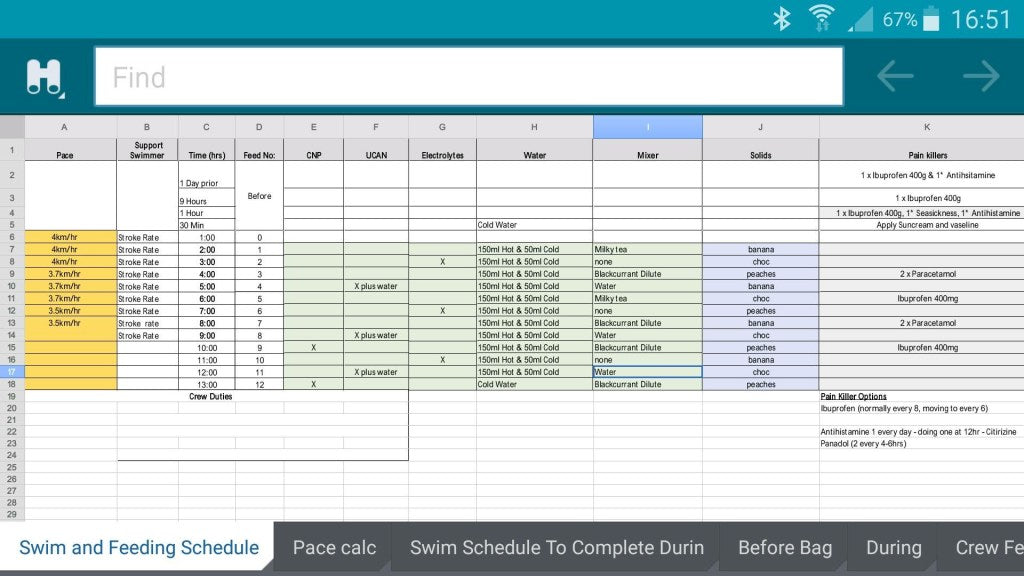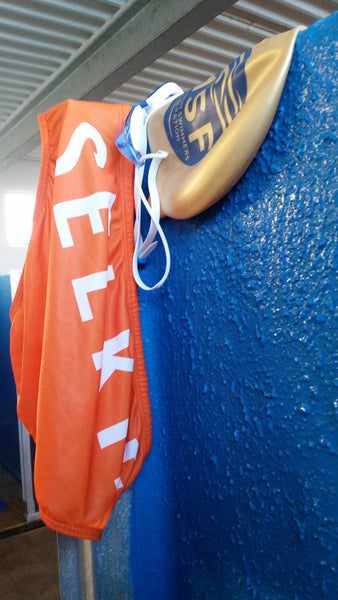Nutrition plans for Marathon Swims by Nicholas Murch
Posted on Thursday, December 05 2019 05:35:00 PM in News by Karen Lee
After my blog on nutrition for Teamselkie last year, people have asked me what I have used during a swim. So I have decided to share my nutrition plan for both split swims like the Champion of Champions and Geneva relay (hourish long swims, few hours rest) and the North Channel – likely 12 hours plus. I will also, in future, share my training log for my English channel crossing as this is another common question that Channel aspirants ask. My training this year has been more, um, minimal.
I have an interest in the science behind open water swimming; trying to demystify some of the old wives’ tales. An area of particular expertise is nutrition for marathon swims. I’m well known to be built for comfort and not for speed and have an ability to eat that more than matches my ability to swim.
Some background for those who don’t know me:
My marathon swims to date are:
- Windermere one way (10 miles) 2015, 4h36
- English Channel crossing (21 miles) 2016, 11h40
- Lake Geneva Signature 70 solo (42 miles, fifth person to complete it officially) 2016, 32h46 with membership of the ’24 hour club’.
For Windermere, I had very little thought about nutrition as I was naive and inexperienced. For the other two, I used ‘traditional’ feeds of maltodextrin (CNP, Maxim, etc.) but with gastrointestinal side effects.
I also, very surprisingly, managed to win the relative sprint of the 2018 British Long Distance Swimming Association Champion of Champions (South) event (5 then 3 then 1 miles) which was good practice for relay preparation and refueling.

In the run up to the North Channel, I did my 6 hour qualifying swim on tea and warm blackcurrant juice with an ice cream at 5 hours for my salt water tongue – bliss! Proof that high carbohydrate energy drinks are not required for everyone. As I’ve stated before, channel swimmers go to fat burning early in a swim and sugary drinks can cause insulin spikes which in turn reduce the ability for the body to use fat as a fuel source.
People may point to fact that nutrition info released regarding Chris Froome (and presumably Bradley Wiggins and soon to be Sir Geraint Thomas) uses a maltodextrin / fructose mix which clearly works for him, but cyclists can take small amounts often and so avoid the insulin spikes. Top channel swimmers do this too – small amount every 5 to 7 minutes.
Those of us who feed for a psychological boost and for our team to assess us during a longer swim, usually feed hourly which is clearly not the same.
I am plesased to have had continued success in 2018 which has brought me my North channel swim (Northern Ireland to Scotland, 21.5 miles), 11h48 in waters at 10 to 12 degrees (‘Number 53’) which was one of the coldest crossings on record as well as the Lake Geneva Signature 70 relay (four person, 42 miles) 2018, 22h05
A split swim like champion of champions or a relay of 2 hours each or less is a different prospect to a longer swim, as there is carbohydrate available as glycogen in the body. So routine advice about carbo-preloading and reloading is correct in my opinion. After each of my legs for C of C and the Geneva relay,I used a recovery drink with protein, electrolytes and carbohydrate and ate pasta, snickers and bananas – if Science in Sport, Mars or Fyffes read this, please send supplies!
Some confounding factors for the attached feeding plan – adapted from one sent from the excellent Infinity channel swimming – as requested by my North Channel pilot. It’s a bit like a school maths puzzle to solve pre-swim.
- Dispersible paracetamol can not go in tea or coffee so use blackcurrant juice
- Electrolyte with caffeine tastes of cola so no mixer needed
- Ucan (sustained release carbohydrate that may avoid insulin spikes) was chocolate flavoured but does not in my experience have enough liquid so needs a water chaser
- Maltodextrin only for a boost towards the end of the swim if really need a sugar rush, don’t want a sugar crash after!
- Tea and coffee – models own 😉

I also let my team surprise me at times…
I hardly touched my solids during the swim as I didn’t want them.
I vomited twice on the boat on the way back from Scotland to Northern Ireland, not sea sickness! The maltodextrin was sitting high and I suspect I had delayed gastric emptying. I’d also been fed ‘early’ which meant I had too much volume.
Looking forward I’m keen to explore opportunities to research nutrition in marathon swimming and this I hope is a real prospect if we can find some funding.
I hope this feeding plan is a useful point of reference for marathon swimmers. And remember: Train as you mean to fight, and do what works for you.
Here is my previous blog on nutrition : Nutrition in Long Distance Swimming – Bonkers Behaviour



